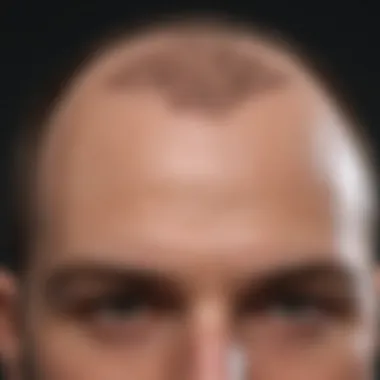Understanding Hair Transplant Scar Healing Time


Intro
Hair transplant procedures have gained significant popularity over the years, thanks to advancements in technique and technology. However, understanding the scar healing time that follows these procedures is crucial for patients. Healing time can vary widely among individuals, influenced by numerous factors. Knowing what to expect can help manage patient expectations and promote effective recovery.
Research Highlights
Overview of Key Findings
Research shows that the scar healing process post-hair transplant is not uniform. Individual healing times can differ based on age, genetic factors, health status, and the specific type of hair transplant procedure undertaken, such as Follicular Unit Extraction (FUE) or Follicular Unit Transplantation (FUT).
The healing stage typically progresses through several phases:
- Hemostasis: The immediate response to injury, which occurs within minutes.
- Inflammation: Starts hours after surgery and lasts for several days.
- Proliferation: Beginning about a week post-op, this phase focuses on tissue formation.
- Maturation: This final phase can last for months to years, leading to refined scarring.
Significance of the Research
Understanding these phases and individual variability is essential. It not only enhances patient knowledge but also aids medical professionals in providing tailored aftercare instructions. This information can potentially reduce scarring, enhance aesthetic outcomes, and, ultimately, improve patient satisfaction.
Key Factors Influencing Healing Time
Several factors can affect the healing process. These include:
- Patient's Age: Younger patients generally heal faster compared to older individuals who may have slower regeneration processes.
- Individual Health Conditions: Conditions such as diabetes or autoimmune disorders can complicate wound healing.
- Type of Hair Transplant: FUE often results in less visible scarring compared to FUT, due to the different extraction methods.
- Post-operative Care: Adherence to care protocols directly impacts the recovery timeline and scarring.
Post-operative Care Essentials
Good care after a hair transplant is vital in reducing visible scars. Key practices include:
- Keeping the surgical area clean and moisturized.
- Avoiding physical strain in the first weeks post-surgery.
- Following the surgeon's guidelines on medications and topical applications.
- Scheduling follow-up appointments to monitor healing.
Important: Failing to follow post-operative instructions can lead to prolonged healing times and increased visibility of scars.
Closure
In summary, hair transplant scar healing time is a multifaceted process influenced by diverse factors. Understanding this complexity allows individuals to prepare adequately for the journey ahead. Knowledge about healing stages, signals to watch for, and effective post-operative care strategies will ultimately facilitate a smoother recovery.
For further reading on this topic, resources such as Wikipedia and Britannica can provide additional insights.
Prologue to Hair Transplantation
Hair transplantation is an increasingly popular solution for individuals experiencing hair loss. This area of cosmetic surgery has gained attention not only for its effectiveness but also for its evolving techniques and approaches. Understanding hair transplantation involves recognizing both the surgical process and the potential for post-operative challenges, such as scar healing.
The significance of hair transplant surgery extends beyond mere aesthetics. It can impact a person's self-esteem and overall psychological well-being. Many patients view hair as a vital part of their identity, and loss due to conditions like androgenetic alopecia can lead to significant emotional distress.
Surgical options available in the field present varied methods of harvesting hair follicles, each with its implications for the healing process. The scars that form after a transplant are a critical topic of discussion. Understanding how these scars develop and heal can directly influence a patient’s satisfaction and expectations regarding the procedure.
In the subsequent sections, we will explore the specifics of hair transplant surgery, the techniques used, and how they relate to scar formation. This exploration will help build a clearer picture of the entire process, highlighting the interaction between surgical methods and individual healing capacities.
Understanding Scar Formation


The process of scar formation is a central aspect of hair transplant recovery. Scars can impact not only the final aesthetic result of the procedure but also a patient's psychological well-being. Understanding how scars form gives valuable insight into minimizing their appearance and promoting effective healing. It is crucial for both patients and practitioners to comprehend the dynamics involved in scar tissue creation. This knowledge can inform post-operative care strategies and expectations surrounding healing time.
Physiology of Scar Tissue
Scar tissue forms as part of the natural healing process. When the skin is damaged, whether through surgical intervention or injury, the body initiates a complex series of biological responses aimed at repairing the damage. In hair transplantation, the process involves removing hair follicles and creating incisions or extraction sites.
Fibroblasts, a type of cell responsible for producing collagen, are activated in response to injuries. Collagen provides strength and structure to the tissue. As fibroblasts proliferate, they build new collagen and extracellular matrix, gradually forming scar tissue. This newly formed tissue is often less elastic than the surrounding skin, leading to visible scarring. Over time, the scar may fade but will typically remain more noticeable than original tissue.
Factors Influencing Scarring
Several factors play a significant role in how scars form and heal after a hair transplant:
Genetics
Genetics can significantly influence how individuals scar. Some people have a genetic predisposition to hypertrophic scars or keloids, which are raised and often larger than the original wound. This characteristic can complicate the healing process. Studies suggest that individuals with a family history of problematic scarring carry a higher risk of similar outcomes after surgery. It is worth noting that the variability in genetic makeup underscores the need for personalized treatment plans and post-operative instructions based on individual risk factors.
Age
Age is another critical element affecting scar formation. Younger individuals generally heal faster and form less conspicuous scars than older adults. This may be attributed to more robust cellular activity and better vascularity in younger skin. Conversely, aging skin often has reduced elasticity and regenerative capacity, which can lead to more pronounced scar tissue. Understanding the implications of age on healing is essential for tailoring recovery strategies effectively.
Skin Type
Skin type, including factors like thickness, oiliness, and sensitivity, can also determine healing. Individuals with thicker skin may experience more significant collagen deposition and, subsequently, larger or raised scars. Skin sensitivity can affect how one responds to surgical trauma and post-operative care. Therefore, it is beneficial to assess skin type before surgery to offer appropriate care recommendations during the healing period.
Post-Operative Care
Post-operative care is paramount in managing scar formation. Adhering to instructions provided by healthcare providers can significantly affect healing and scar appearance. Essential aspects of care include keeping the surgical area clean, avoiding sun exposure, and following prescribed treatments like silicone gel sheets or moisturizers. Implementing these measures helps minimize the risk of complications and promotes optimal healing outcomes. Each patient's situation is unique, thus personalized guidance during recovery can be invaluable.
"Understanding the biology of scar formation equips patients with the knowledge to take control of their recovery process."
In summary, recognizing the factors involved in scar formation allows patients and practitioners to adopt informed approaches regarding post-operative care. This understanding ultimately leads to better outcomes and greater satisfaction with the results of hair transplantation.
Scarring After Hair Transplant
Understanding scarring after hair transplant is crucial for anyone considering this procedure. The scars left behind can influence not only the aesthetic results but also how the patient feels about the outcome. Scars can vary significantly from person to person, making it essential for patients to familiarize themselves with their potential healing journey. In this section, we will discuss the expected healing timeline as well as the factors that contribute to variability in healing times. By recognizing these elements, patients can set realistic expectations and engage in effective post-operative care to minimize scarring.
Expected Healing Timeline
After a hair transplant, the healing process unfolds over several stages. Immediately after the procedure, patients may experience some swelling and redness at the donor and recipient sites. Within the first week, crusting and scabbing may occur as the wounds begin to close. Most patients see initial healing by the end of two weeks, with many returning to normal activity by this time. However, complete scar maturation can take several months.
- Weeks 1-2: Initial recovery begins, with mild swelling and redness.
- Weeks 3-4: Crusting resolves, and the transplanted hair may shed.
- Months 2-3: Healing progresses, with fading of visible scars.
- Months 6-12: Final appearance of scars becomes evident, with most patients experiencing significant fading.
A clear understanding of this timeline helps avoid unnecessary worry and prepares individuals for their new look.
Variability in Healing Times
Several factors impact how quickly and effectively scars heal following a hair transplant. Two primary aspects stand out:
Individual Response to Surgery
Individual response to surgery is a major contributor to healing times. Every person’s body reacts differently to surgical trauma, influenced by factors like genetics and overall health. Some individuals may heal quickly with minimal scarring, while others might face prolonged healing periods.


The key characteristic of individual response is that it is highly subjective. Some people find that they have a natural ability to heal faster, which is beneficial as it can lead to less visible scarring. The unique feature lies in the body’s capacity to regenerate tissues, which can provide long-term advantages in terms of skin elasticity and reduced scar visibility.
However, the variability in individual recovery can also mean that patients with slower healing responses may require more intensive post-operative care, increasing the overall complexity of the recovery process.
Type of Transplant Method
The type of transplant method used plays a significant role in the healing process. There are two primary methods: Follicular Unit Transplantation (FUT) and Follicular Unit Extraction (FUE). Each method has distinct impacts on scarring.
The key characteristic of FUT is that it involves removing a strip of scalp, which can leave a linear scar at the donor site. This scar can be more noticeable if healing does not occur optimally. On the other hand, FUE involves extracting individual follicular units, resulting in multiple small puncture wounds rather than a single scar. This can lead to less visible scarring, which is a popular choice among patients aiming for minimal track marks.
The unique feature of the FUE method typically translates into quicker recovery with less noticeable scarring, although it might be more time-consuming and costly compared to FUT. The desired aesthetic outcome has a significant influence on which method a patient may choose, emphasizing the importance of thorough discussions with surgical teams to ensure the chosen method aligns with healing expectations.
Caring for Your Scars
Caring for your scars after a hair transplant is essential for optimal recovery and aesthetic results. This process can influence the extent to which your scars heal and their visibility over time. Understanding how to care for these scars helps in minimizing their appearance, promoting better healing, and ensuring comfort in the recovery phase. A systematic approach to post-operative care can address common concerns such as infection, irritation, and drying of the scalp.
When patients engage in diligent scar care, it may reduce the chances of complications and improve the overall satisfaction with their hair transplant results. The goal becomes not just to recover fully but also to do so in a way that maintains the natural look of your scalp.
General Post-Operative Care
Post-operative care plays a significant role in scar management following a hair transplant. It begins immediately after the surgery and continues well into the healing phase.
- Follow Aftercare Instructions: Surgeons typically provide specific aftercare guidelines. This includes how to wash your hair, when to change bandages, and signs of infection to watch for.
- Avoid Direct Sunlight: Exposure to UV rays can darken scars and impede healing. Using a hat or staying in the shade is advisable.
- Gentle Cleansing: When washing the scalp, opt for a mild shampoo. Avoid scrubbing the area as this can disrupt the delicate healing process.
- Avoid Strenuous Activity: Activities that lead to excessive sweating should be avoided for at least a few weeks post-surgery.
Engaging in proper post-operative care improves healing times and minimizes unsightly scars.
Topical Treatments and Products
Topical treatments can significantly aid in the management of scars. Two primary products frequently used are silicone gel sheets and moisturizers. Each has distinct features that contribute to the overall goal of scar healing.
Silicone Gel Sheets
Silicone gel sheets are often recommended for scar management. These sheets create a moist environment that is conducive to healing. One key characteristic of silicone gel sheets is their ability to flatten and soften scar tissue. They are typically easy to apply and can be worn for most of the day.
- Benefits: Silicone gel sheets are effective in reducing the visibility of scars over time. They work by regulating hydration at the scar site, which can help lessen inflammation.
- Considerations: While effective, some individuals might find the adhesive uncomfortable or irritating to sensitive skin. Regularly cleaning the area beneath the sheet is also vital to prevent any potential irritation.
Moisturizers
Moisturizers serve another vital role in scar care by keeping the skin hydrated. Maintaining moisture is particularly important for the healing tissues. A key characteristic of moisturizers is their ability to prevent dryness that may hinder recovery.
- Benefits: Regular application can reduce itchiness and discomfort associated with healing scars. Additionally, hydration plays a role in improving the appearance of the scar over time.
- Considerations: It is essential to choose a non-comedogenic moisturizer to avoid clogging the pores and potentially leading to breakouts. Always consult a healthcare provider regarding which specific products are suitable during healing.
Caring for your scars effectively involves a balance of good hygiene, protective measures, and the use of topical treatments. Implementing these strategies can enhance recovery and improve the appearance of scars, supporting a smoother transition back to daily life.
Managing Expectations
Managing expectations is a critical aspect of the hair transplant journey. Understanding what to anticipate post-surgery can drastically influence a person’s experience. Patients frequently focus on the end result, but it is equally important to consider the entire healing process and its implications. Most patients arrive with high hopes for immediate results, which can lead to disappointment if they are not prepared for the healing timeline and potential imperfections.
Setting realistic expectations about scar healing can lead to more satisfactory outcomes. This includes understanding how scars develop, what should be normal during recovery, and the typical timeline for healing. Each individual's body has a unique way of responding to surgical procedures. Factors such as age, skin type, and overall health can affect healing.


Another key component of managing expectations is preparation for emotional responses. Scars may not heal uniformly, and some variation in healing appearance is common. A patient’s state of mind is essential during this period. Knowing what to expect can help in coping with the psychological effects of visible scars.
It is critical to communicate openly with the medical team. They can provide insights into the expected healing journey. This openness can lead to a better understanding of the outcomes and what it means for one’s self-image and confidence. Overall, managing expectations based on informed understanding can significantly enhance the hair restoration experience.
Realistic Outcomes Post-Surgery
Realistic outcomes post-surgery are fundamental to the patient experience. After undergoing a hair transplant, it is essential to recognize that results will not be immediate. Hair restoration is a gradual process, often requiring several months for significant changes to become visible. Most transplant procedures encompass a shedding phase where transplanted hairs may fall out initially before new hair growth commences.
Healing timelines and outcomes can be affected by several factors:
- Procedure Type: Different methods like FUT or FUE have distinct healing characteristics and scar appearances.
- Individual Healing Rates: Each person’s body responds differently, leading to variations in scar maturity.
- Post-Operative Care: Adhering to recommended practices can help minimize scarring and promote better healing.
The goal should be to appreciate the transformation as it unfolds over time. Generally, most patients start to see more defined hair growth around six to eight months post-surgery. The final appearance may take up to a year, depending on individual factors.
Psychological Impact of Scarring
The psychological impact of scarring is a significant consideration in the hair transplant process. Scars are often accompanied by a blend of emotions, which can range from anxiety to regret. For many, hair loss is intertwined with identity. The prospect of surgery can evoke hope but also fear, particularly regarding visible scars.
A noticeable scar can lead to self-consciousness. The psychological burden may include intrusive thoughts about appearance and self-esteem. Thus, it is vital for patients to engage in discussions with mental health professionals if needed. This can assist them in navigating feelings of distress.
Moreover, support networks from friends and family can be invaluable. Sharing experiences and hearing from others who have undergone similar procedures can help demystify the healing process. Creating a sense of community can ease anxiety and foster resilience.
In summary, the psychological effects of scarring should not be underestimated. By acknowledging and addressing these feelings, patients can work towards a more positive experience during recovery.
Complications and Considerations
Understanding the complications and considerations surrounding hair transplant procedures is critical for potential patients. It not only prepares them for the reality of post-operative care but also enhances their understanding of the healing process. This section aims to provide insights on potential risks associated with hair transplants and offers guidance on when to seek medical advice.
Potential Risks Associated with Hair Transplants
Hair transplants, while generally safe, are not devoid of risk. The complications can vary widely, influenced by factors such as the patient's health, the surgical technique, and the skill of the surgeon. Here are some potential risks to consider:
- Infection: As with any surgical procedure, there is a risk of infection. Maintaining sterile conditions during and after the surgery is vital to minimize this risk.
- Scarring: Unsightly scars can occur, especially with the FUT technique, where a strip of scalp is removed. The way scars heal is unique to each individual and depends on their skin type and healing capacity.
- Bleeding: Some bleeding is expected, but excessive bleeding requires immediate attention. This issue may arise during or after the procedure.
- Numbness: Some patients report temporary or permanent numbness in areas where the incision was made.
- Poor Hair Growth: Sometimes, the transplanted hair does not grow as expected. Factors like the quality of the donor hair can affect this result.
It is essential to weigh these risks against the benefits of the procedure when making a decision about undergoing a hair transplant.
When to Seek Medical Advice
Knowing when to seek medical advice post-operation is crucial for managing complications effectively. Patients should be vigilant for any signs that may indicate a problem. Here are some guidelines:
- Fever: Developing a fever after surgery can be a sign of infection. This should always be addressed immediately.
- Excessive Pain or Discomfort: While pain is expected post-surgery, any significant increase in pain levels should be investigated by a healthcare professional.
- Persistent Bleeding: If bleeding continues beyond the normal time frame, it is vital to consult with a surgeon to discuss the issue.
- Poor Wound Healing: If the surgical site does not seem to be healing or shows signs of dehiscence, medical intervention is necessary.
- Any Unusual Symptoms: Uncommon symptoms like pimples on the scalp, discharge from the surgical site, or increase in redness should be reported.
In summary, understanding complications and recognizing when to seek medical help is fundamental to achieving satisfactory results from a hair transplant. Patients should engage with their healthcare provider actively, ensuring they have clear guidelines on post-operative care and are informed about the potential risks involved.
The End
In this article, we have explored the vital aspects of hair transplant scar healing time. Understanding this topic is crucial for anyone considering hair transplantation. It is not just about the surgery itself; it is about the recovery process and the expected outcomes post-surgery.
Recap of Key Points
The key points covered include:
- Healing Timeline: We discussed the general timeline for healing after hair transplants, which varies significantly among individuals. Factors such as the type of hair transplant technique and the body's healing response were highlighted.
- Scar Management: Effective post-operative care can drastically minimize scarring. This includes the use of topical treatments such as silicone gel sheets and maintaining proper hygiene at the surgical site.
- Realistic Expectations: It is crucial to manage expectations regarding scarring. Recognizing that some scarring is common and may take time to fade aids in mental preparation for the post-surgery period.
Future Perspectives on Hair Transplant Techniques
The future of hair transplant techniques looks promising. Innovations in technology, such as robotics and improved surgical techniques, may enable more precise procedures, resulting in less scarring. Additionally, ongoing research in regenerative medicine offers potential pathways for enhancing the body's natural healing processes.







